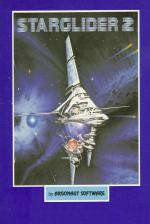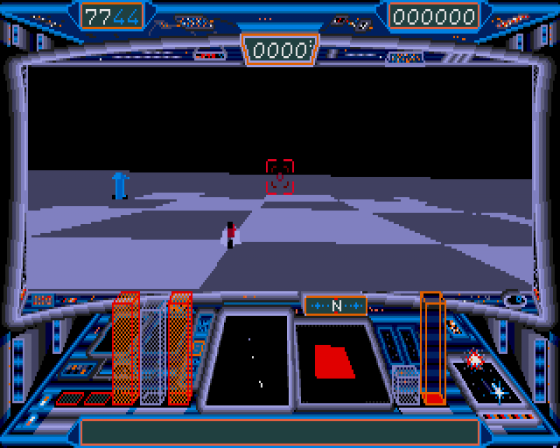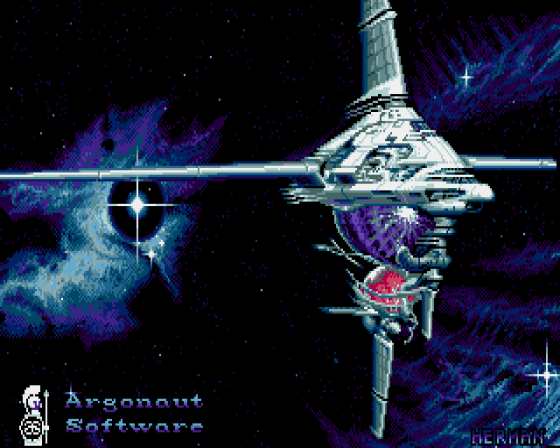
The One
 1st October 1988
1st October 1988
Categories: Review: Software
Author: Steve Jarratt
Publisher: Argonaut
Machine: Amiga 500
Published in The One #1
Starglider II (Rainbird)
The true power of 16-bit machines is no more fully realised than when putting to task the manipulation of complex 3D images. Rainbird's Starglider II shows just how well that particular exercise can be achieved... as Steve Jarratt found to his amazement.
Following on from their earlier success with the wire-frame vector graphic shoot-'em-up, Starglider, Jez Sans and his Argonaut Software team have spent the past eighteen months creating an entire solar system to be explored - only this time it's all filled in, and colourful, too. The system comprises five planets and their moons, all orbiting the central star, Solice. An Egron invasion force (the bad guys from Starglider) have seized the whole system and are currently building a giant plasma beam weapon in orbit around the fifth planet. Protected by seven smaller projectors on the seven moons of the third planet, the completed beam weapon is to be used on the distant planet of Novenia - the sole opposition to the Egrons taking over the entire Galaxy.
To prevent the fall of Novenia (and consequently, the rest of the Galaxy) the aim of the player's mission is to enter the system in a specially modified police ship, contact the remaining Solician forces and help them to build and deliver a Neutron Bomb - the only weapon powerful enough to destroy the Egron's beam projector.
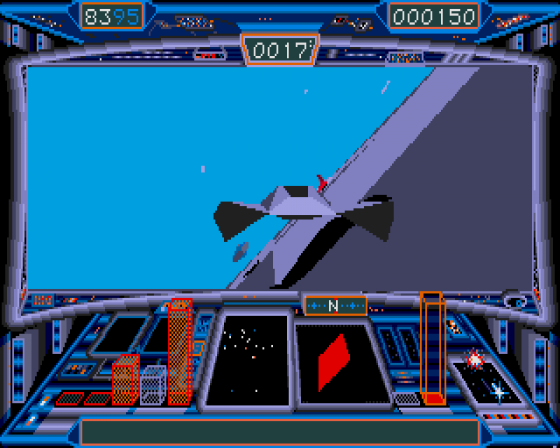
The Solicians have taken refuge in a series of interconnecting tunnels which honeycomb the interiors of several planets and moons. Once contacted, the Solicians outline the items required for the construction of the device, and the player is sent on an intergalactic scavenger hunt.
The basic scenario outlined above only begins to scratch the surface of the mission, and your ship has to be constantly refuelled and rearmed in order to ensure progress. Many of the items required are only obtained through bartering, which in turn depends upon the collection of further materials, and so on.
Locating and collecting the necessary items for construction of the bomb shouldn't prove too difficult once the system has been explored and mapped. However, the full intricacies of the mission will take longer to master and completing it is a more than worthy challenge. It is reckoned by the Argonaut team that it takes a seasoned pilot around three hours to complete the mission from start to finish. A game save option Is included, which should prove vital for success.
Argonaut Software
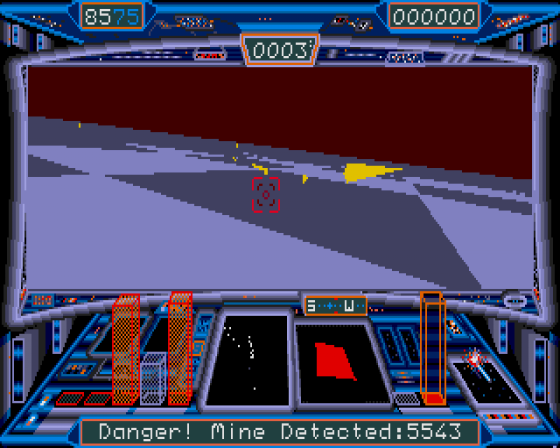
Jez Sans began computing with a TRS80, way back in 1976. He rapidly worked his way through a variety of 8-bit machines, and later worked on conversion problems on Firebird's 64 version of Elite. Tony Rainbird was so pleased with his work at this time that he asked Jez to produce a game - any game, and he would publish it.
"I was very interested in the mathematics of creating 3D imagery, and began work on a vector graphic routine using a Sinclair QL. I found the QL unsuitable for the type of things I wanted to do, and so hired an Apple Mac to work on. A few months later the Atari ST appeared and I saw it as an ideal machine for my applications."
Thus began the work on the original Starglider. It was an immense success.

"Starglider made enough money to fund Argonaut Software which now number ten strong, and is in the process of recruiting new blood. But as far as I'm concerned, Starglider wasn't finished. I really wanted to continue with it, refining the routines and adding extra things; but suddenly Rainbird wanted the game for release, so I had to stop.
"I'm much more satisfied with Starglider II, though. We've optimised the routines and I belleve it's as fast, if not faster than Starglider. And it's filled-in.
"Starglider II has had over five man-years lavished on it, and the development costs, including new equipment and premises means that even if Starglider I sells well, we probably still won't recoup all our expenses.
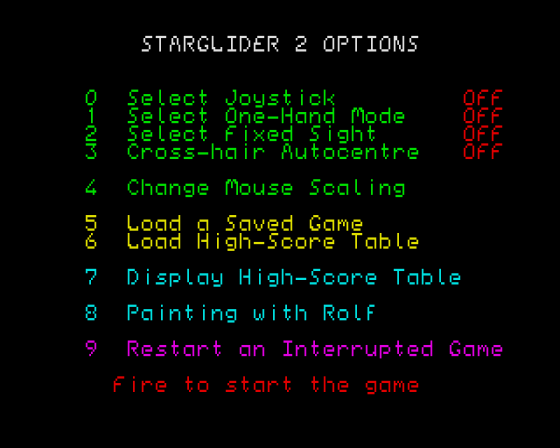
"My reasons for doing Starglider I and II were to implement the 3D maths as well as possible; to get it to do what you want it to do. And to make a fast, exciting and playable game.
"Starglider II was definitely a team effort: there's a lot of code sharing, and we all help each other out in the development process.
"It's an ongolng situation though: we sell the games to publishers, but the technology remains ours. In effect, producing Starglider was the development work for Starglider II, and producing Starglider II the development work for our next project, and so on."

What is their latest project?
"At the moment we're working on two, the first of which is Hawk for Electronic Arts, which has been in development more or less since we finished Starglider. Hawk features an enormous landscape complete with fractal-generated mountains over which the player flies a sophisticated aircraft. EA wanted it ready in September, but we'll be lucky to have it completed this year. We don't want to stop until we have the best thing around - it already is, but we want to make it even better.
"At the moment it contains the most detailed 3D Images ever seen on a home computer. There are tons of enemy craft: helicopters, tanks, F18's, F19's and a few imaginary Stealth planes. Each vehicle has up to 30 facets and there are often more than one craft on-screen at a time. When it's really busy, you can have far more than 100 polygons on-screen and the frame rate is still pretty rapid. We've actually got Hawk to run 20% faster than Starglider II."

Argonaut also have the 16-bit versions of Afterburner for Electric Dreams, for which they have produced sophisticated sprite-handling routines.
"We now have a sprite engine which can manipulate hand-drawn sprites at high speed, moving them, reducing and expanding them at will. We are currently working on the ST version which is coming along extremely well. The Amiga version could well be identical to the arcade version; we believe it's the closest conversion to date."
"The quality of other conversions have been generally poor. The best on so far has been Buggy Boy, and even that could have been better. We do watch the opposition, but simply to ensure that we remain original."

So what of the future?
"We can now use our sprite engine in conjunction with the 3D graphics routines to create detailed 3D games. We can generate the solid, 3D shapes and sweeten them by having sprite generated explosions, exhaust fumes, insignia and so on.
"We are watching CDI closely, but ultimately, we would like to move into coin-op game production. We are also interested in converting our games to the consoles, specifically the Nintendo and PC Engine. This isn't definite - but it's a possibility."
Amiga

The Solician system and its inhabitants are depicted in beautiful detail. The 3D is very fast, very smooth and entirely believable. In fact, rather than being a vehicle for the gameplay, it's almost the reverse: gameplay really takes a back seat to the visuals. It's all too easy to spend the first few hours - even days - just flying around, taking in all the sights and sounds which Starglider II has to offer.
Indeed the imagery is often quite stunning. There's a huge array of constructions, vehicles and objects to be discovered, from simple buildings to spinning towers, asteroids, pirate ships - dead ringers for the twin pod cloud cars from The Empire Strikes Back - to the amazing Egron mechanical whale which must be seen to be appreciated. The gameplay is simpler than first appears, or is insinuated by the manual (which, rather than being an extravagant and superfluous addition to the package, proves a humorous and informative read, acting as an obscure instruction manual/hint sheet).
The large amount of sampled sound effects also act a prime factor to the game's atmosphere, adding to the whole experience. But whatever the shortcomings of its individual elements, the game as a whole is an extremely worthy purchase.
ST
There's little to separate the ST and Amiga versions graphically. The ST Starglider II is slightly slower and rather less smooth, but only the closest examination reveals any serious differences. Its major fault, though, lies with the sound. The atmosphere, so ably generated by the Amiga sampled sound effects, is unfortunately lacking here. The decision to avoid the samples effects was taken by the Argonaut team, who said it would cause the game to run 20% slower if they were included. This leaves the ST's sound chip to cope as best it can, and as a result the effects are quite harsh, with little to commend them. This deficiency means that Starglider II is only very good instead of great.
PC
The PC version of Starglider II is all set for a January release, and is also being programmed by the Argonaut team. By all accounts, progress is good and they hope to support Tandy, EGA, CGA and VGA graphics cards (VGA versions could also support the powerful MVGA which would prove better than the Amiga and ST versions).
Other Reviews Of Starglider 2 For The Amiga 500
Starglider 2 (Rainbird)
Zzap Gold Medal Award: A perfect demonstration of just what an Amiga can do
Other Amiga 500 Game Reviews By Steve Jarratt
Scores
Amiga 500 Version| Graphics | 92% |
| Sound | 95% |
| Playability | 86% |
| Value For Money | 84% |
| Overall | 89% |
Scores
Atari ST Version| Overall | 89% |

